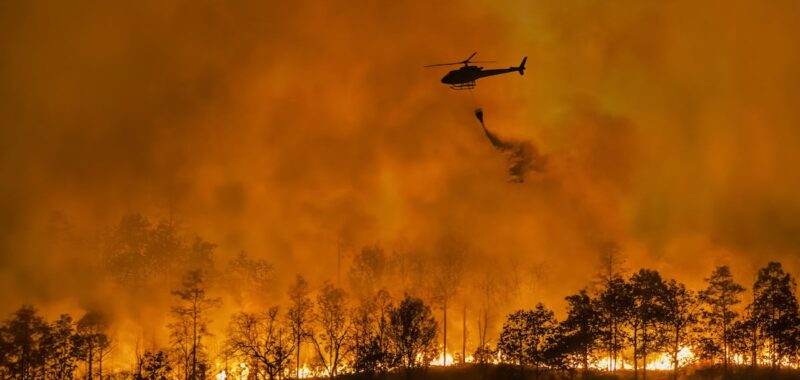
Dry, hot winds will fan blazes in Los Angeles into midweek â and some forecasts show little relief for the rest of the month â as Southern California struggles with one of the worst starts to a year for wildfires.
While good progress has been made blunting two of the regionâs smaller blazes, the largest are raging almost out of control Sunday even as thousands of firefighters take on the infernos in what the city fire chief described as a ârelentless air attack.â Firefighters from across the US, as well as Canada and Mexico, have converged in California to assist in battling the flames.
The weather is proving a formidable foe. Red flag fire warnings have been posted through Wednesday as wind sweeps the region, spreading blazes, turning vegetation to fuel and making water dropped from aircraft less effective. More than 8.4 million people will face critical fire-weather conditions Sunday, and that danger will linger for days, the US Storm Prediction Center said, with no rain in the forecast.
A stagnant pattern of high pressure and low pressure across the West has created a natural funnel to blast winds over Southern California.
âIt is a disastrous pattern and there is not much chance of it changing,â said Bob Oravec, a senior branch forecaster at the US Weather Prediction Center. âIf anything it just looks like it reloads across the West and it looks like it gets worse by the end of the month.â
Expanded evacuation areas include the ultra-affluent neighbourhoods of Brentwood and Bel Air, as well as some of Los Angelesâ most important cultural institutions. The Getty Center, an architectural landmark with a world-class art collection, has a fire-resistant design that may be put to the test.
The devastation had killed 16 people as of Saturday night. Eleven died in the city of Altadena from the Eaton Fire, while five perished in the Palisades fire.
Thirteen people are missing, officials said. Another 19 have been arrested in the Eaton Fire and an additional three in the Palisades for curfew violations, burglary and looting. More than 16,000 people have applied for assistance from the Federal Emergency Management Agency, Regional Administrator Bob Fenton said.
By late Saturday, the Palisades Fire near Malibu had burned 23,654 acres and was only 11 percent contained, while the the Eaton blaze close to Pasadena had consumed 14,117 acres and was 15 percent contained, officials said. More than 10,000 structures have been destroyed in the two fires, placing them as the third- and fourth-most destructive in state history.
California Governor Gavin Newsom on Sunday issued an executive order aimed at helping Los Angeles rebuild faster once the fires are contained. The order suspends certain state environmental and permitting regulations, including the California Environmental Quality Act and California Coastal Act, to expedite the rebuilding of homes and businesses in affected areas. Newsom also extended anti-price gouging protections in Los Angeles County until January 2026.
The fires threaten to worsen a region already grappling with some of the highest US housing costs, with the governor warning that delays in rebuilding could drive up homelessness and further inflate housing prices.
âWhen the fires are extinguished, victims who have lost their homes and businesses must be able to rebuild quickly and without roadblocks,â Newsom said in a statement.
On NBCâs Meet the Press, the governor said: âWeâve got to be thinking three weeks, three months, three years ahead at the same time weâre focusing on the immediacy, which is life safety and property.â
At least 101 fires have started this month, which is higher than last yearâs 39 and the five-year average of 46, according to the California Department of Forestry and Fire Protection, commonly called Cal Fire.
In addition to the threats posed to residents, the University of California, Los Angeles has told students and staff all classes will be remote through at least Jan. 17 and the entire campus is operating under emergency conditions, according to its website.
At least 17,587 emergency responders have joined the fight. Newsom also announced Saturday that he has doubled National Guard personnel working on the fires to 1,680 responders. Altogether, the state has deployed more than 14,000 people to support firefighting efforts.
California officials have invited President-elect Donald Trump to tour the areas damaged by the fires, but he hasnât responded to them publicly. His staff didnât immediately respond to a request for comment.
The fires also have put pressure on utilities that preemptively cut electricity to residents. Edison Internationalâs Southern California power company has been asked by attorneys representing insurance companies to preserve evidence in connection with the Eaton Fire.
Edison has also said fire agencies are investigating whether the companyâs equipment was involved in the ignition of the smaller Hurst Fire near San Fernando. âRight now, we donât have any evidence that says that the Hurst Fire was caused by our equipment, but thereâs a lot more investigation to be done,â President and CEO of Southern California Edison Steven Powell told reporters Saturday.
As of Sunday, 63,485 customers were without power, PowerOutage.us said.
The US Bureau of Alcohol, Tobacco and Firearms is investigating the fires, Los Angeles Police Chief Jim McDonnell announced Saturday.
California has a history of devastating wildfires sparked by electric utility equipment during wind storms. The stateâs largest utility, PG&E Corp., filed for bankruptcy in 2019 after a series of deadly blazes blamed on its wires.
The fires are the most devastating natural disaster to strike Los Angeles since the 1994 Northridge earthquake, which killed 57 people, and are likely to rank among the costliest natural disasters in modern US history. Commercial-forecaster AccuWeather Inc. estimates direct and secondary losses, which account for uninsured destruction and indirect economic impact such as lost wages and supply-chain disruptions, may reach between $135 billion to $150 billion.
By Brian K. Sullivan

